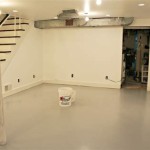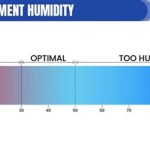How To Paint a New Basement Concrete Floor
Painting a new basement concrete floor is a cost-effective way to enhance the aesthetics and functionality of your basement space. A properly painted floor offers protection against moisture, dust, and staining, while also providing a more visually appealing and comfortable environment. This article provides a comprehensive guide on how to paint a new basement concrete floor, covering preparation, material selection, application techniques, and necessary safety precautions.
A "new" concrete floor for the purposes of this guide typically refers to a floor that has cured for at least 28 days after being poured and has not been previously sealed or painted. This curing period allows the concrete to fully harden and release excess moisture. If the concrete is not fully cured, the paint may not adhere properly and can lead to premature peeling or bubbling.
The successful execution of a paint job on a new basement floor relies heavily on meticulous preparation. A thorough preparation process will ensure proper adhesion of the paint, extending its lifespan and enhancing the overall appearance of the finished floor. Improper preparation can lead to paint failure, necessitating costly repairs and reapplication.
Key Point 1: Surface Preparation is Paramount
The first step in preparing a new concrete floor for painting is a thorough cleaning. Even if the floor appears clean, it is crucial to remove any dust, debris, or efflorescence (a white, powdery substance that can appear on concrete surfaces due to moisture). A shop vacuum equipped with a brush attachment is effective for removing loose debris. Following the vacuuming, scrub the floor with a solution of trisodium phosphate (TSP) mixed with water, according to the manufacturer's instructions. TSP is a powerful cleaner that effectively removes grease, oil, and other contaminants that can inhibit paint adhesion.
After scrubbing, rinse the floor thoroughly with clean water to remove all traces of TSP. It is important to ensure that no TSP residue remains, as it can negatively affect the paint's bonding properties. Use a wet/dry vacuum to remove the excess water, or allow the floor to air dry completely, which may take several hours or even a day, depending on the humidity and temperature.
Following the cleaning, the next critical step is to profile the concrete surface. Concrete typically has a smooth, dense surface that is not conducive to paint adhesion. Profiling involves roughening the surface to create a mechanical bond for the paint to grip onto. This can be achieved through several methods, including acid etching, mechanical grinding, or shot blasting. For a residential basement floor, acid etching is often the most practical and cost-effective option.
Acid etching involves applying a diluted solution of muriatic acid to the concrete surface. Always wear appropriate safety gear, including eye protection, gloves, and a respirator, when working with muriatic acid. Follow the manufacturer's instructions carefully regarding dilution ratios and application procedures. Apply the acid solution evenly over the concrete surface using a plastic watering can or a chemical-resistant sprayer. The acid will react with the concrete, creating a slightly rough texture. The etching process should create a profile similar to fine sandpaper.
Allow the acid to react with the concrete for the recommended time specified by the manufacturer, typically 10-15 minutes. After the etching process is complete, neutralize the acid with a solution of baking soda and water. This will stop the etching process and prevent any further damage to the concrete. Rinse the floor thoroughly with clean water to remove all traces of acid and baking soda. Use a wet/dry vacuum to remove the excess water and allow the floor to dry completely. The drying process can take 24-48 hours, depending on the ambient conditions.
Once the floor is thoroughly dry, assess the surface for any remaining imperfections, such as cracks or holes. Fill these imperfections with a concrete patching compound or epoxy filler, following the manufacturer's instructions. Allow the patching compound to cure completely before proceeding with the painting process. Sand the patched areas smooth to blend them seamlessly with the surrounding concrete surface.
Key Point 2: Selecting the Right Paint and Primer
Choosing the appropriate paint and primer is critical for a successful and long-lasting paint job on a basement concrete floor. The basement environment is typically characterized by high levels of moisture and humidity, so it is essential to select products that are specifically designed to withstand these conditions. Two primary types of coatings are generally recommended for basement concrete floors: epoxy coatings and acrylic latex paints formulated for concrete floors. Each offers distinct advantages and disadvantages.
Epoxy coatings are known for their exceptional durability, resistance to chemicals, and ability to withstand heavy foot traffic. They form a hard, protective layer that is highly resistant to staining, abrasion, and impact. Epoxy coatings are also available in a wide range of colors and finishes, allowing for customization of the floor's appearance. However, epoxy coatings are typically more expensive than acrylic latex paints, and they can be more challenging to apply, often requiring specialized tools and techniques.
Acrylic latex paints formulated for concrete floors are a more affordable and user-friendly option. These paints are specifically designed to adhere to concrete surfaces and resist moisture damage. They are also easier to apply than epoxy coatings and can be cleaned up with soap and water. However, acrylic latex paints are generally less durable than epoxy coatings and may be more susceptible to staining and abrasion. They may also require more frequent reapplication than epoxy coatings, especially in high-traffic areas.
Regardless of the type of paint chosen, it is essential to use a primer specifically designed for concrete floors. A primer serves several important functions: it seals the concrete surface, improving adhesion of the topcoat; it blocks moisture from penetrating the concrete and damaging the paint; and it helps to prevent efflorescence from forming on the surface. Choose a primer that is compatible with the chosen paint type, and follow the manufacturer's instructions carefully regarding application procedures and drying times.
When selecting a paint color, consider the overall aesthetic of the basement and the amount of natural light available. Lighter colors can help to brighten up a dark basement, while darker colors can create a more cozy and inviting atmosphere. Also, consider the potential for staining and choose a color that will effectively hide stains or dirt. A semi-gloss or gloss finish is generally recommended for basement floors, as these finishes are more durable and easier to clean than matte finishes.
Key Point 3: Proper Application Techniques
The application process is crucial for achieving a professional-looking and durable paint job. Begin by thoroughly mixing the paint or epoxy according to the manufacturer's instructions. Use a mixing stick or a paint mixer attachment for a drill to ensure that the paint is properly blended. Avoid shaking the paint, as this can create air bubbles that can affect the finish.
Apply the primer to the prepared concrete floor using a paint roller with a nap length appropriate for the surface texture. A 3/8-inch or 1/2-inch nap is generally suitable for most concrete floors. Use an extension pole to reach difficult areas and to avoid bending over excessively. Apply the primer in thin, even coats, overlapping each stroke slightly to ensure complete coverage. Allow the primer to dry completely according to the manufacturer's instructions, typically 24-48 hours.
Once the primer is dry, begin applying the paint or epoxy. Follow the same application techniques as with the primer, using a paint roller with the appropriate nap length. Apply the paint in thin, even coats, overlapping each stroke slightly. Work in small sections to maintain a wet edge and prevent lap marks. Use a brush to paint along the edges of the floor and in tight corners. Avoid applying the paint too thickly, as this can lead to drips, runs, and slow drying times.
Allow the first coat of paint to dry completely before applying the second coat. The drying time will vary depending on the type of paint and the ambient conditions, but it is typically recommended to wait at least 24 hours between coats. Before applying the second coat, inspect the floor for any imperfections, such as drips or runs. Sand these imperfections smooth with fine-grit sandpaper before proceeding.
Apply the second coat of paint in the same manner as the first coat. This coat will provide added durability and coverage, resulting in a more uniform and professional-looking finish. Allow the second coat to dry completely before walking on the floor or placing any furniture on it. The curing time for the paint will vary depending on the type of paint and the ambient conditions, but it is typically recommended to wait at least 72 hours before subjecting the floor to heavy traffic.
For added protection and durability, consider applying a clear topcoat over the painted floor. A clear topcoat will provide a sacrificial layer that protects the paint from scratches, stains, and wear. Choose a topcoat that is compatible with the chosen paint type, and follow the manufacturer's instructions carefully regarding application procedures and drying times.
Throughout the entire painting process, ensure proper ventilation. Open windows and doors to allow fresh air to circulate, and use a fan to help dissipate fumes. Wear a respirator to protect yourself from inhaling paint fumes. Avoid painting in direct sunlight or in excessively hot or humid conditions, as this can affect the paint's drying time and adhesion.
By following these detailed instructions and taking the necessary precautions, you can successfully paint a new basement concrete floor, transforming it into a durable, attractive, and functional space. Remember that patience and attention to detail are key to achieving a professional-looking and long-lasting result.

How To Paint A Concrete Floor Southern Hospitality

Diy Painted Basement Concrete Floor In The House Of David

How To Paint Concrete Flooring Moving Com

11 Diy Upcycle And Paint Makeover Projects Concrete Basement Floors Remodel

Painting Cinder Block Walls In A Basement Or Re Paint Them

How To Paint Concrete Basement Floors Building Bluebird

7 Ingenious Painted Flooring Ideas For An Unfinished Basement

A Guide To Stained Concrete Basement Floors

How To Make A Diy Painted Concrete Floor Hometalk

9 Of The Best Concrete Paints For Garage And Basements Basement Design Layout Flooring Options








